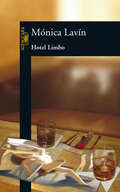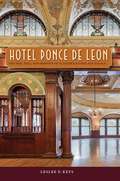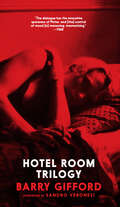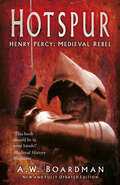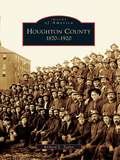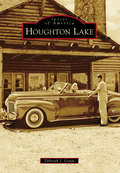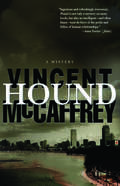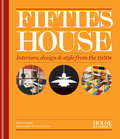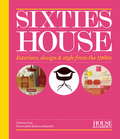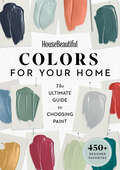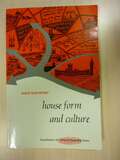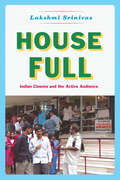- Table View
- List View
Hotel Limbo
by Mónica Lavín¿Tu vida es aburrida? Vive el Buen Fin entre deseos, aventuras y decisiones que le darán esa intensidad que necesitas En esta novela la autora narra la llegada a una ciudad de Sara Martínez. Ha llegado hasta ese lugar para impartir un curso sobre de cómo hablar en público o seducir con la palabra. Pero Sara resulta seducida por uno de sus alumnos, o más bien seducida por el deseo mismo, ya que aun antes de cualquier insinuación de su pupilo, ella ya imagina un encuentro con el muchacho. Deseo que de alguna manera se trunca, pues el alumno parece evadir la cita definitiva. En cambio quien llega es Darío, un pintor que busca atrapar la sensualidad suprema. Así, entre modelo y creador se va gestando una complicidad en la que cada uno va descubriendo su historia, llena de desencuentros: a él lo abandonaron su esposa e hijo, ella en cambio decidió hacer a un lado el hastío de su matrimonio. Narración colmada de alegrías, tristezas, enojos, lo que es decir vida, pero también de esos momentos en la historia de la pintura en los que los grandes maestros lograron atrapar la sensualidad, el deseo. El deseo es un destello, un resplandor que cuando aparece no tiene intención de permanecer. Es fugitivo y huye al menor descuido. Por eso cuando lo intuimos, procuramos cerrarle los espacios, que no se escape por algún resquicio. Hotel Limbo de Mónica Lavín logra capturar este efímero deleite. ¿Tu vida es aburrida? Vive el Buen Fin entre deseos, aventuras y decisiones que le darán esa intensidad que necesitas En esta novela la autora narra la llegada a una ciudad de Sara Martínez. Ha llegado hasta ese lugar para impartir un curso sobre de cómo hablar en público o seducir con la palabra. Pero Sara resulta seducida por uno de sus alumnos, o más bien seducida por el deseo mismo, ya que aun antes de cualquier insinuación de su pupilo, ella ya imagina un encuentro con el muchacho. Deseo que de alguna manera se trunca, pues el alumno parece evadir la cita definitiva. En cambio quien llega es Darío, un pintor que busca atrapar la sensualidad suprema. Así, entre modelo y creador se va gestando una complicidad en la que cada uno va descubriendo su historia, llena de desencuentros: a él lo abandonaron su esposa e hijo, ella en cambio decidió hacer a un lado el hastío de su matrimonio. Narración colmada de alegrías, tristezas, enojos, lo que es decir vida, pero también de esos momentos en la historia de la pintura en los que los grandes maestros lograron atrapar la sensualidad, el deseo. El deseo es un destello, un resplandor que cuando aparece no tiene intención de permanecer. Es fugitivo y huye al menor descuido. Por eso cuando lointuimos, procuramos cerrarle los espacios, que no se escape por algún resquicio. Hotel Limbo de Mónica Lavín logra capturar este efímero deleite.
Hotel Lobbies and Lounges: The Architecture of Professional Hospitality (Interior Architecture)
by Anne Massey Tom AvermaeteThis series investigates the historical, theoretical and practical aspects of interiors. The volumes in the Interior Architecture series can be used as handbooks for the practitioner and as a critical introduction to the history of material culture and architecture. Hotels occupy a particular place in popular imagination. As a place of exclusive sociability and bohemian misery, a site of crime and murder and as a hiding place for illicit liaison, the hotel has embodied the dynamism of the metropolis since the eighteenth century. This book explores the architectural significance of hotels throughout history and how their material construction has reflected and facilitated the social and cultural practices for which they are renowned. Contemporary developments in the planning and design of hotels are addressed through a series of interviews and case studies. Illustrated throughout, this book is an innovative and important contribution to architectural and interior design theory literature.
Hotel Mariachi: Urban Space and Cultural Heritage in Los Angeles (Querencias Series)
by Enrique R. Lamadrid Catherine L. KurlandIn Boyle Heights, gateway to East Los Angeles, sits the 1889 landmark &“Hotel Mariachi,&” where musicians have lived and gathered on the adjacent plaza for more than half a century. This book is a photographic and ethnographic study of the mariachis, Mariachi Plaza de Los Angeles, and the neighborhood. The newly restored brick hotel embodies a triumphant struggle of preservation against all odds, and its origins open a portal into the Mexican pueblo&’s centuries-old multiethnic past.Miguel Gandert&’s compelling black-and-white images document the hotel and the vibrant mariachi community of the &“Garibaldi Plaza of Los Angeles.&” The history of Hotel Mariachi is personal to Catherine López Kurland, a descendant of the entrepreneur who built it, and whose family&’s Californio roots will fascinate anyone interested in early Los Angeles or Mexican American history. Enrique Lamadrid explores mariachi music, poetry, and fiestas, and the part Los Angeles played in their development, delving into the origins of the music and offering a deep account of mariachi poetics. Hotel Mariachi is a unique lens through which to view the history and culture of Mexicano California, and provides touching insights into the challenging lives of mariachi musicians.
Hotel Mexico: Dwelling on the '68 Movement
by George F. FlahertyIn 1968, Mexico prepared to host the Olympic games amid growing civil unrest. The spectacular sports facilities and urban redevelopment projects built by the government in Mexico City mirrored the country’s rapid but uneven modernization. In the same year, a street-savvy democratization movement led by students emerged in the city. Throughout the summer, the ‘68 Movement staged protests underscoring a widespread sense of political disenfranchisement. Just ten days before the Olympics began, nearly three hundred student protestors were massacred by the military in a plaza at the core of a new public housing complex. In spite of institutional denial and censorship, the 1968 massacre remains a touchstone in contemporary Mexican culture thanks to the public memory work of survivors and Mexico’s leftist intelligentsia. In this highly original study of the afterlives of the ’68 Movement, George F. Flaherty explores how urban spaces—material but also literary, photographic, and cinematic—became an archive of 1968, providing a framework for de facto modes of justice for years to come.
Hotel Ponce de Leon: The Rise, Fall, and Rebirth of Flagler's Gilded Age Palace
by Leslee F. KeysHistoric St. Augustine Research Institute William L. Proctor Award Henry Flagler's opulent Hotel Ponce de Leon drew worldwide praise from the day its elaborately carved doors opened in 1888. Built in the Spanish Renaissance Revival style, the architectural and engineering marvel featured the talents of a team of renowned artisans, including the designs of architects John Carrère, Thomas Hastings, and Bernard Maybeck, electricity by Thomas Edison, and interior decoration and stained glass windows by Louis Tiffany. Hotel Ponce de Leon is the first work to present the building's complete history and detail its transformation into the heart of Flagler College. Leslee Keys, who assisted in the restoration, recounts the complicated construction of the hotel--the first major structure to be built entirely of poured concrete--and the efforts to preserve it and restore it to its former glory. The methods used at Flagler College have been recognized as best practices in historic preservation and decorative arts conservation, and today the campus is one of Florida's most visited heritage tourism destinations.
Hotel Room Trilogy: Three one-act plays
by Barry GiffordFrom the award-winning author and screenplay writer, a trio of one-act plays depicting the spooky, strange, and tragic passage of guests through the same New York City hotel room (number 603).&“The dialogue has the evocative spareness of Pinter, and [the] control of mood [is] menacing, mesmerizing.&” —TIMEThe tangible mystery of these stories is grounded in the peculiar relationships that unfold slowly, producing an unrelenting uncanny atmosphere. In each play, a family member has recently died and the survivors are left to deal with the consequences. In "Tricks" Gifford approaches the psychological territory of Kafka. We meet two men looking for something more than just sex from a prostitute. Are the men two halves of a severed personality? In "Blackout" Danny and Diane, an Oklahoma couple of the 1930s, cannot move beyond the grief of a personal tragedy. Refusing to accept the death of her son, Diane seeks refuge in low-level deliriums.In "Mrs. Kashfi" a young boy experiences a spooky visitation while his mother voyages into the sea of clairvoyance with a fortune teller.Written for David Lynch's 1993 drama Hotel Room for HBO, two of these stories, "Tricks" and "Blackout" were nominated for the Cable Ace Award.&“Gifford&’s night people are a strange mix of utter weirdness and bedrock humanity, rampant eccentricity, and absolute individuality. Some things in life are beyond analysis, and Barry Gifford is one of them." —Booklist
Hotel Theory
by Wayne KoestenbaumHotel Theory is two books in one: a meditation on the meaning of hotels, and a dime novel (Hotel Women) featuring Lana Turner and Liberace. Typical of Wayne Koestenbaum’s invigoratingly inventive style, the two books - one fiction, one nonfiction - run concurrently, in twin columns, and the articles "a,” "an,” and "the” never appear. The nonfiction ruminations on hotels are divided into eight dossiers, composed of short takes on the presence of hotels in the author’s dreams as well as in literature, film, and history. Guest stars include everyone from Oscar Wilde to Marilyn Monroe. Hotel Theory gives (divided) voice to an aesthetic of hyperaesthesia, of yearning. It is an oblique manifesto, the place where writing disappears. A new mode of theorizing - in fiction, in fragment, through quotation and palimpsest - arises in this dazzling work.
Hotels (Cutaways)
by Jules O'DwyerFrom Marienbad to the Bates Motel, cinematic hotels are more than a mere backdrop to a film’s action. They actively scaffold the formal, aesthetic, and narrative possibilities of cinema. This book takes a journey through spaces of temporary dwelling—hotels, inns, and motels—to delve into the dynamics and contradictions that structure modern life.Along the way, O’Dwyer considers questions of plot and eroticism, labor and globalization, and the ethics and economics of hospitality. Drawing on a broad array of films from European art cinema to experimental adult media, and placing cinema into dialogue with film theory and media history, Hotels explores both how and why the hotel has such a strong purchase on the cinematic imaginary.
Hotspur: Henry Percy: Medieval Rebel
by Andrew Boardman‘This book should be in your hands!’ – Medieval History Magazine'A detailed and readable account of Hotspur’s life that conveys a sense of the endemic violence of the Border Marches.’ – Northern History‘Boardman has studied the battlefields of Otterburn, Homildon Hill and Shrewsbury and combines knowledge of terrain, weapons, and tactics with contemporary narratives to produce feasible reconstructions and explanations of what actually occurred.’ – Michael HicksImmortalised by Shakespeare in Henry IV, Part I, Henry Percy, nicknamed ‘Hotspur’, is among the best known of all his warlike characters.As the young, honourablebut impatient rebel soldier whose chivalrous exploits on the battlefield end in disaster at Shrewsbury in 1403, Hotspur is the archetypal anti-hero: a character of such tragic and dramatic significance that even his well-known nickname has passed from history into legend. But who was the historical Henry Percy, and why did his rise to fame bring him into direct confrontation with his king?This fully updated book tells the story of the real Henry Percy and his overbearing family, and how the survival of a great northern dynasty led to open rebellion and ultimately military failure.
Houdini On the Spot: Power User Tips and Techniques (On The Spot {{series}} Ser.)
by Craig ZerouniPacked with more than 350 techniques, this book delivers what you need to know-on the spot. Its concise presentation of professional techniques is suited to experienced artists whether you are:* Migrating from another visual effects application* Upgrading to Houdini 9* Seeking a handy reference to raise your proficiency with HoudiniHoudini On the Spot presents immediate solutions in an accessible format. It clearly illustrates the essential methods that pros use to get the job done efficiently and creatively. Screenshots and step-by-step instructions show you how to:* Navigate and manipulate the version 9 interface* Create procedural models that can be modified quickly and efficiently with Surface Operators (SOPs) * Use Particle Operators (POPs) to build complex simulations with speed and precision* Minimize the number of operators in your simulations with Dynamics Operators (DOPs) * Extend Houdini with customized tools to include data or scripts with Houdini Digital Assets (HDAs) * Master the version 9 rendering options including Physically Based Rendering (PBR), volume rendering and motion blur* Quickly modify timing, geometry, space and rotational values of your animations with Channel Operators (CHOPs)* Create and manipulate elements with Composite Operators (COPs); Houdini's full-blown compositor toolset* Make your own SOPs, COPs, POPs, CHOPs, and shaders with the Vector Expressions (VEX) shading language * Configure the Houdini interface with customized environments and hotkeys* Mine the treasures of the dozens of standalone applications that are bundled with Houdini
Houdini: The Man Who Walked Through Walls
by William Lindsay GreshamFirst published in 1959, this is a fascinating look at the life and career of magician and escape-artist Harry Houdini (1874-1926). Author William Gresham interviewed many people who knew Houdini personally, adding greatly to the book's accuracy and authoritativeness, and he also reviewed all of the available books, and newspaper and magazine articles on the magician. Gresham explains many of Houdini's illusions, and debunks some of the many myths surrounding the performer. Houdini's interest in the supernatural is examined, as are his efforts to expose the many fraudulent mediums and spiritualists of the time. Included are 8 pages of photographs.
Houghton County: 1870-1920
by Richard E. Taylor"Go West, young man . . ." When Horace Greeley made his famous statement in the pages of Harper's Weekly, he was not referring to the goldfields of the late-1840s California, he was speaking of Michigan's western Upper Peninsula. In the mid- to late 1840s, Michigan's copper resources were rediscovered by state geologist Douglass Houghton, setting off a mining boom rivaled only by the gold rush of 1849. The richest copper and silver ores, and even some gold, were found in the mines of Houghton County. Famous mines such as "Old Reliable," the Quincy mine, and the Calumet and Hecla mines gave up billions of tons of pure native copper and millions of dollars to eastern investors for over 100 years. Railroads, steamship lines, and eventually trolley lines served Houghton County, offering connection to the outside world. Between 1850 and 1920, mining companies attracted immigrants from Cornwall, England; Germany; Italy; Finland; Ireland; the Austro-Hungarian empire; and French Canada. The area was a true melting pot. Although this era of prosperity saw the rise of labor unions, the period culminated in the tragic and unsuccessful strike of 1913.
Houghton Lake
by Deborah I. GouinNestled among northern Michigan's pine trees in Roscommon County is the state's largest inland lake, Houghton Lake. Lumbermen made use of its 20,044 acres to move timber. They banked logs on the lake, the headwaters of the Muskegon River, during the winter cutting season and drove them downriver in the spring to southwestern lumber yards. As Houghton Lake's reputation for good fishing grew, visitors came to try their luck. By the mid-20th century, Houghton Lake became one of the most popular destinations in Michigan. Now, the area is known for its bars, resorts, and winter festival Tip-Up Town USA. Water sports, summer cottages, and nightlife still attract thousands of visitors from Lower Michigan and surrounding states today.
Hound
by Vincent MccaffreyHenry Sullivan makes his living as a book hound. When an ex-lover is murdered, he mounts an unofficial investigation that leads him through the murky depths of Boston's literary world.
House & Garden Fifties House (House & Garden)
by Catriona GrayThe post-war consumer boom of the 1950s, coupled with a desire for new, innovative design resulted in one of the most exciting decades in the history of interiors - a visual revolution that was captured on the pages of British House & Garden.In Fifties House, mid-century modern enthusiast Catriona Gray has drawn on the magazine's peerless archive, curating the best illustrations and photographs to show how the use of colour, pattern, homewares and furniture evolved through the decade. The homes of key tastemakers are featured including Le Corbusier, Giò Ponti, Terence Conran and Hans and Florence Knoll. The first title in the new Decades of Design series, House & Garden Fifties House is required reading for mid-century modern enthusiasts, collectors and decorators in search of inspiration from the most influential homes of the past.
House & Garden Sixties House: Interiors, design & style from the 1960s (House & Garden)
by Catriona Gray House & GardenFrom Pop art to Op art, plastic furniture to bubble-gum paint colours, the Sixties saw a new wave of interior design that was closely linked to popular culture and fashion, becoming increasingly youth-oriented and playful to appeal to the new generation of baby-boomers. In Sixties House, mid-century modern enthusiast Catriona Gray has drawn on the magazine's peerless archive, curating the best illustrations and photographs to show how the use of colour, pattern, homewares and furniture evolved through the decade. The homes of key tastemakers are featured including Bridget Riley, Mary Quant, David Mlinaric, Barbara Hulanicki of Biba and David Bailey. The second title in the new Decades of Design series, House & Garden Sixties House is required reading for mid-century modern enthusiasts, collectors and decorators in search of inspiration from the most influential homes of the past.
House (Random House Reader's Circle Ser.)
by Tracy KidderIn the New York Times bestseller House, Pulitzer Prize–winning author Tracy Kidder takes readers to the heart of the American Dream: the building of a family's first house with all its day-to-day frustrations, crises, tensions, challenges, and triumphs.In Kidder's "remarkable piece of craftsmanship in itself" (Chicago Tribune), constructing a staircase or applying a coat of paint becomes a riveting tale of conflicting wills, the strength and strain of relationships, and pride in skills. With drama, sensitivity, and insight, he takes us from blueprints to moving day, shedding light on objects usually taken for granted and creating a vivid cast of memorable characters in the process."The making of a house is a strange blend of dreams and mundane work, of heaven and earth, and Mr. Kidder has explained it."??—??New York Times Book Review
House Beautiful Colors for Your Home: The Ultimate Guide to Choosing Paint
by House BeautifulBased on House Beautiful&’s popular color column, this pocket-sized handbook shows how a simple coat of paint can set the mood and add a designer's touch in any room. This gorgeous primer showcases more than 450 colors selected by top interior designers who explain how and why they chose these particular paints—along with swatches complete with manufacturer, name, and number, to help you pick the perfect pigment. Exploring everything from bold saturated hues to more soothing shades and essential neutrals, the designers offer special insight into what makes color work and how it influences the different spaces. The insider advice, plus stunning images of inspiring rooms, will help you select the ideal colors you&’ll enjoy for years.
House Divided
by John Lorinc Alex Bozikovic Cheryll Case Annabel VaughanA citizen's guide to making the big city a place where we can afford to live. Housing is increasingly unattainable in successful global cities, and Toronto is no exception - in part because of zoning that protects "stable" residential neighborhoods with high property values. House Divided is a citizen's guide for changing the way housing can work in big cities. Using Toronto as a case study, this anthology unpacks the affordability crisis and offers innovative ideas for creating housing for all ages and demographic groups. With charts, maps, data, and policy prescriptions, House Divided poses tough questions about the issue that will make or break the global city of the future.
House Form And Culture (Geography Ser.)
by Amos RapoportAn historical approach to the broad variety of primitive and peasant dwellings and the forces that affect them
House Full: Indian Cinema and the Active Audience (Fieldwork Encounters and Discoveries)
by Lakshmi SrinivasIndia is the largest producer and consumer of feature films in the world, far outstripping Hollywood in the number of movies released and tickets sold every year. Cinema quite simply dominates Indian popular culture, and has for many decades exerted an influence that extends from clothing trends to music tastes to everyday conversations, which are peppered with dialogue quotes. With House Full, Lakshmi Srinivas takes readers deep into the moviegoing experience in India, showing us what it's actually like to line up for a hot ticket and see a movie in a jam-packed theater with more than a thousand seats. Building her account on countless trips to the cinema and hundreds of hours of conversation with film audiences, fans, and industry insiders, Srinivas brings the moviegoing experience to life, revealing a kind of audience that, far from passively consuming the images on the screen, is actively engaged with them. People talk, shout, whistle, cheer; others sing along, mimic, or dance; at times audiences even bring some of the ritual practices of Hindu worship into the cinema, propitiating the stars onscreen with incense and camphor. The picture Srinivas paints of Indian filmgoing is immersive, fascinating, and deeply empathetic, giving us an unprecedented understanding of the audience's lived experience--an aspect of Indian film studies that has been largely overlooked.
House Goals: Design with architects, transform your home
by Ruth SlavidWhat would you do if you could reinvent your home? A link to the garden, to bring nature closer. A re-thought layout, that complements your lifestyle. A greener home, for a sustainable future (and lower energy bills). More space. Better space. You probably know what is wrong with your house, but do you really know what would improve it? Architects do. Even better, they can design a home that works for you, with ideas and solutions that you may not yet have considered. This stunningly illustrated book showcases the best examples of what can be achieved when homeowners collaborate with RIBA-certified architects to realise their House Goals. Sorted by motivation, it breaks down how architects can address these universal problems in unique, bespoke ways that suit their clients, while providing inspiration for your own home. Crucially, House Goals fully explains the process of working with architects – from first contact to completion – to ensure you know exactly what you’re getting into, and how to make the most of it. Features: Examples of projects in Georgian, Victorian, Edwardian, inter-war and post-war homes. A range of scales, from one-bed flats and split-level maisonettes to two-up, two-down terraces and cosy cottages, elegant town houses and detached homes as well as interesting conversions and garden rooms. Rural and urban locations ranging from hamlets to big cities, covering: London, Norfolk, Cheshire, Sussex, Herefordshire, Yorkshire, Oxfordshire and more. Work from more than 30 architects, including: Arboreal Architecture, Bradley Van der Straeten Architects, Gagarin Studio, IF_DO, Knox Bhavan and nimtim architects. With a foreword by Kevin McCloud.
House Gods: Sustainable Buildings and Renegade Builders
by Jim KristoficOur buildings are making us sick. Our homes, offices, factories, and dormitories are, in some sense, fresh parasites on the sacred Earth, Nahasdzáán. In search of a better way, author Jim Kristofic journeys across the Southwest to apprentice with architects and builders who know how to make buildings that will take care of us. This is where he meets the House Gods who are building to the sun so that we can live on Earth. Forever.In House Gods, Kristofic pursues the techniques of sustainable building and the philosophies of its practitioners. What emerges is a strange and haunting quest through adobe mud and mayhem, encounters with shamans and stray dogs, solar panels, tragedy, and true believers. It is a story about doing something meaningful, and about the kinds of things that grow out of deep pain. One of these things is compassion—from which may come solace. We build our buildings, we make our lives—we are the House Gods.
House Histories for Beginners
by Colin Style O-Lan StylePopular television programmes highlight the satisfaction that can be gained from investigating the history of houses, and there is always plenty of interest in the subject, with archives becoming ever more accessible with access to the internet.As the subject covers a broad field, the authors have set out to include advice on those aspects that usually apply to a project and others that will be of particular use for beginners. The reader is guided through every stage of research, from the first exploration of the archives to the completion of the task. Suggestions are also included on how to present the findings – a house history makes a very attractive gift.The authors describe how to deduce the age of a property (it is very seldom directly recorded when a house was built) and characteristics of research on particular types of property – such as cottages, manor houses, inns, mills, former church properties, and farms – are discussed. In one example, research demonstrated that a farm was likely to have been a Domesday manor – a fascinating discovery achieved using records accessible to any beginner.
House Lessons: Renovating a Life
by Erica BauermeisterFROM NEW YORK TIMES BESTSELLING AUTHOR ERICA BAUERMEISTER COMES A MEMOIR ABOUT THE POWER OF HOME—AND THE TRANSFORMATIVE ACT OF RESTORING ONE HOUSE IN PARTICULAR. &“I think anyone who saves an old house has to be a caretaker at heart, a believer in underdogs, someone whose imagination is inspired by limitations, not endless options.&” In this mesmerizing memoir-in-essays, Erica Bauermeister renovates a trash-filled house in eccentric Port Townsend, Washington, and in the process takes readers on a journey to discover the ways our spaces subliminally affect us. A personal, accessible, and literary exploration of the psychology of architecture, as well as a loving tribute to the connections we forge with the homes we care for and live in, this book is designed for anyone who&’s ever fallen head over heels for a house. It is also a story of a marriage, of family, and of the kind of roots that settle deep into your heart. Discover what happens when a house has its own lessons to teach in this moving and insightful memoir that ultimately shows us how to make our own homes (and lives) better.
